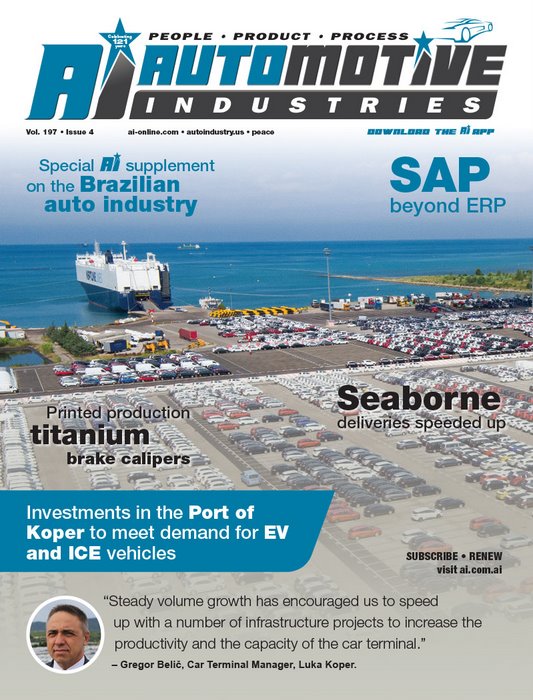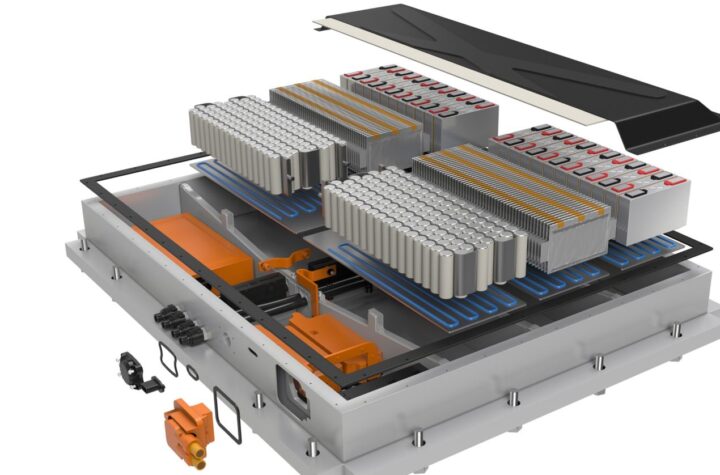
One of Europe’s top automotive hubs, the Slovenian port of Koper, has been identified as one of the leaders in preparing for the handling of electric vehicles, while at the same time continuing to invest in new facilities and equipment for vehicles powered by internal combustion engines.
Luka Koper, the port operator, was recognized at the “Electric Vehicles in Logistics and Transportation” conference held in Barcelona as part of the CarEsmatic project as one of the leading car cargo partners in the project together with the operators of the port of Barcelona. Organized by the Barcelona Port Authority, the conference was also attended by electric-vehicle manufacturers Renault, Nissan and Toyota.
Both ports are already working on improving their environmental management systems and energy efficiency, including acquiring electric vehicles for their own needs. “As part of the project both ports plan to set up trial electric filling stations. Shipment trials will be run by Neptune Lines, one of the leading Mediterranean shipping lines.”
As part of the project both ports are setting up electric filling stations and trials shipments were successfully performed by Neptune Lines, one of the leading Mediterranean shipping lines.
Luka Koper reports that the port of Koper is continuing to break its own throughput records, with volumes up more than 40% year-on-year. In one of its best months – March 2018 – it handled 81,561 handled wheeled units, was registered in March which exceeded the record reached in November 2016. In addition to the growth in its vehicle operations Koper has seen growth in
both export and import container volumes. It is handling close to 100 000 containers a month.
Last year, according to Luka Koper, European ports were confronted with many challenges related to market unpredictability, production disruption, lack of capacity, strikes and uncertainty associated with the UK’s withdrawal from the EU. On the other hand, the revitalization of markets in North Africa, Iran and Russia provided new opportunities in both the new and used car sectors.
Luka Koper is planning to build new ro-ro berths to cater for pure car carriers with different loading deck configurations. Construction is expected to start in 2019. The company is also planning a new rail terminal with direct access to automotive warehouses. The investment, expected to be completed in the summer of 2019, anticipates the construction of four 700-metre tracks connected to the external network. About half of the vehicles moving through the port do so on rail.
Automotive Industries (AI) asked Gregor BeliÄ, Car Terminal Manager, Luka Koper, what plans the company has to expand its facilities for cars.
BeliÄ: Steady volume growth has encouraged us to speed up a number of infrastructure projects to increase the productivity and the capacity of the car terminal. A totally new car-carrier berth is planned in the Basin 3 area which will be served by a new rail access from the adjacent storage areas. The beginning of construction of both projects is expected in 2019. Recently we also decided to start the construction of a multi-story garage for 6,000 cars, which will join the existing one which has capacity for 8,000 cars. The main reasons are space optimization, better productivity and meeting higher demand for covered parking lots. Another project, which will improve the internal logistics of the whole port, is a new truck gate which should be completed by March 2019.
AI: What are some of the facilities required for electric/hybrid cars and how do they differ from facilities for traditionally-fueled cars?
BeliÄ: The logistics of EV is bringing new challenges, especially from the infrastructural aspect. We expect that the majority of EV, while waiting in the port, will require power supply, which is logical if you want to optimize the whole supply chain. That’s why we have recently built a new electrical substation to meet the increased consumption. We are already using plug-in stations in the existing garage and the new garage shall be built considering the requirements of EV logistics.
AI: What makes the Port of Koper the 9th largest port for cars and how do you hope to keep your position as such?
BeliÄ: Through the years we have built strong relationships with key automotive producers, ship-owners and their logistics partners, developing the best possible solutions together. In parallel there has been a constant upgrading of facilities, which is crucial for attracting new volumes. A vast network of short-sea and deep-sea services connecting Koper with the Mediterranean, Middle East, Africa and Far East makes us a competitive port on European scale.
AI: Why has there been a surge in business from car logistics despite the general slowdown at your port?
BeliÄ: The general economic growth in Europe and in other parts of the world has had a positive effect on the overall situation in the Port of Koper. Double digit growth has been registered in the car segment because the economic growth induces a boost in consumer’s demand in a relatively short time.
AI: How much of Luka Koper’s business comes from cars?
BeliÄ: We do not disclose the portion of revenues generated by the car terminal. However, the car business is second to container handling as strategically the most important cargo segment handled by the port.
AI: Tell us a little about the Luka Koper’s strategy in making facilities ‘green’.
BeliÄ: Luka Koper implemented an environmental management system certified to the ISO 14001 standard in the year 2000. In 2010 the company joined the voluntary EMAS environmental scheme, which is an upgrade of the already implemented ISO 14001 environmental management system. We have a complete system of monitoring dust and noise levels, and checking the quality of water.
All results are published on our website as part of our commitment to transparent communication and maintaining an honest relationship with the local residents. In recent years we have focused on replacing diesel port machinery with electric, in order to lower emissions, reduce noise and save energy. We have also replaced our yard lighting with more sophisticated systems.
AI: How has business from Asia and other regions been growing and how do you foresee future business from the East?
BeliÄ: For many years Turkey has been a very prominent non-European market for us, with both strong exports and imports. North Africa remains quite volatile in terms of exports, but Morocco is becoming a major production player as its exports to Europe grow. Since 2015 we have a weekly deep-sea service with South East Asia, China and Japan, mostly for luxury cars produced in Europe. There are also regular shipments from Korea and Japan to our port. Here we have still a lot of room for growth. Other areas in which there is still capacity include Ro-Ro, high & heavy and project cargo









More Stories
Sonatus – The industry is shifting gears to software
Cybord warns of dangers of the stability illusion
HERE building trust in ADAS systems